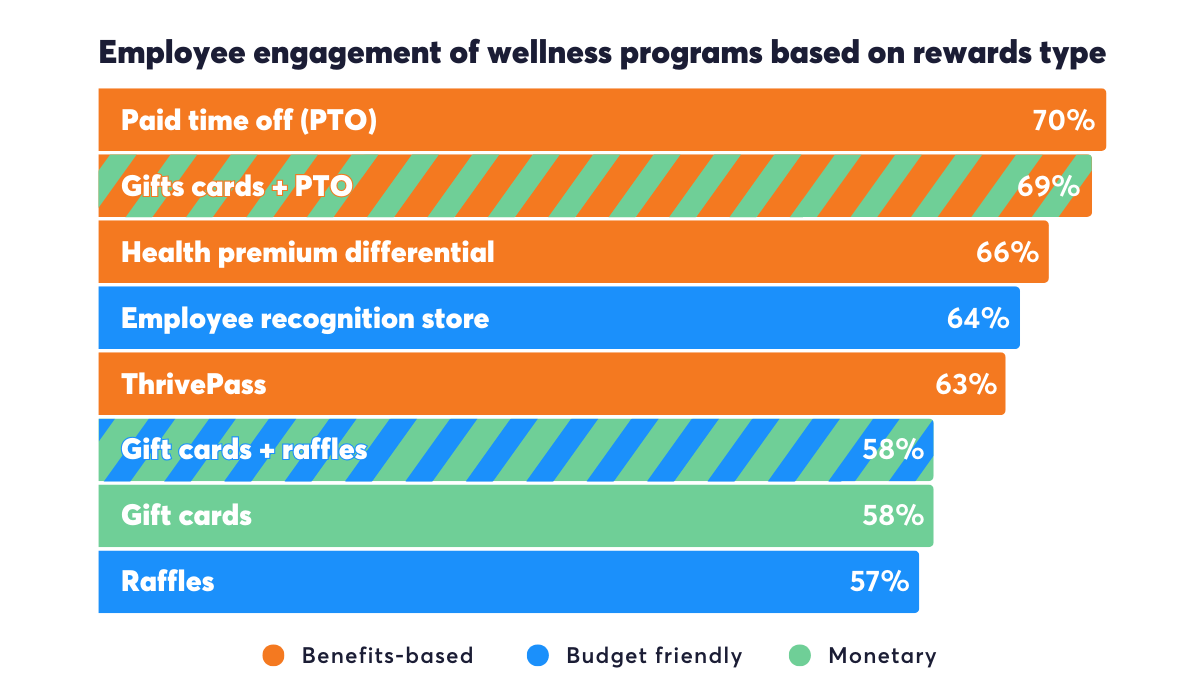While some employees are naturally inclined to join wellness programs, others might need an extra push to get involved. The question on the latter group’s mind is often, “What’s in it for me?”

Wellness incentives are powerful motivators that can encourage even the most reluctant employees to participate in health initiatives. Rooted in psychological and behavioral theories, incentives reinforce positive actions to drive behavior change. Extrinsically, rewards provide tangible reasons to participate regularly (e.g., earning a gift card), while intrinsically, they satisfy the need for recognition and accomplishment (e.g., receiving praise). By connecting wellness goals with incentives, employers create a feedback loop that fosters sustained engagement in health programs.
Long-term participation in wellness initiatives offers dual advantages: employers benefit from increased productivity, reduced healthcare costs, and improved retention, and employees enjoy better physical, mental, and emotional health, along with greater job satisfaction. This mutual gain fosters a healthier, more engaged, and more resilient workforce.
Over 80% of Wellable customers incorporate at least one type of reward into their wellness programs, boosting engagement and supporting ongoing habit formation. On average, these clients see a 59.3% engagement rate, but the top 25%—those who follow best practices and thoughtfully design their incentive programs—achieve an impressive average engagement rate of 89.3%. This highlights the importance of carefully considering incentive type, value, and distribution frequency to maximize program effectiveness.

This white paper analyzes the incentive structures that drive the highest engagement, focusing on optimal reward values, effective reward types, and best practices for utilizing lifestyle spending accounts (LSAs)—a particularly impactful incentive identified through Wellable’s 2023 customer data. Program engagement, defined as the ratio of active users to eligible users, will serve as the primary metric for defining programmatic success. However, organizations should also consider qualitative metrics, such as employee feedback, to fully assess their programs’ efficacy and meet employee needs more effectively.
Drawing on Wellable’s 2023 customer data and insights from ThrivePass (LSA provider driving high engagement), the following evidence-based insights can help organizations create and refine well-being programs that:
- Align with organizational objectives and address unique employee needs
- Optimize budget allocations and increase ROI/VOI
- Cultivate a healthier, more engaged workforce

Types of Rewards and Impact on Engagement
The following subsections focus on the most popular types of rewards used by Wellable customers in 2023, their impact on engagement, and practical implementation tips. For additional incentive ideas to fit the unique needs of your organization, refer to our blog on 25 Incentive Ideas For Your Employees.

Prioritize Benefits-Based Rewards to Maximize Engagement
Benefits-based rewards led to the highest engagement rates, with an average of 65.9%. These incentives support financial well-being, employee health, and work-life balance.
The most popular benefits-based rewards among Wellable customers in 2023 were:
- LSAs: Spending accounts that provide employees with a one-time or recurring stipend for wellness-related expenses.
- Paid time off (PTO): Additional time off from work to support health, well-being, and personal life.
- Premium differential: A reduction in the portion of health insurance premiums deducted from employees’ wages for those who participate in a wellness program.
- Include at least one benefits-based reward in your program to reinforce a commitment to wellness.
- Pair these with other reward types (e.g., monetary, budget-friendly) to create a holistic wellness package.
- Regularly communicate the long-term value of these rewards by hosting informational sessions and showcasing success stories to enhance employee appreciation and engagement.

Offer Monetary Rewards to Meet Diverse Needs
Monetary rewards resulted in an average engagement rate of 57.7%. These rewards are popular for their universal appeal and flexibility, providing employees with autonomy over how they use funds.
The most popular monetary rewards among Wellable customers in 2023 were:
- Gift cards: Electronic gift cards that employees can use for purchases of their choice.
- GlobalGiving contributions: Gift cards provided by Wellable’s partner, GlobalGiving, to fund donations to more than 3,000 charities and projects across the world.
- Payroll contributions: Cash contributions distributed via payroll with the appropriate tax adjustments.
- Offer versatile options (e.g., Visa or Amazon gift cards) to accommodate diverse needs and preferences.
- Provide smaller, frequent incentives to sustain engagement, such as rewarding monthly achievements.
- Pair monetary rewards with benefits-based rewards to meet both short- and long-term needs.
- Maximize the flexibility of monetary rewards with Wellable’s Rewards Wallet, allowing employees to select, store, and redeem rewards easily.

Leverage Budget-Friendly Rewards to Boost Participation Creatively
Budget-friendly incentives are an attractive option for newer companies or organizations with smaller budgets, allowing them to offer meaningful rewards without overextending resources. These incentives resulted in a 50.1% average engagement rate. Although they produce lower engagement rates, budget-friendly rewards can still be effective when used creatively and combined with other incentive strategies.
The most popular benefits-based rewards among Wellable customers in 2023 were:
- Employee recognition: Tokens of appreciation to recognize employees’ efforts and contributions, often in a non-monetary way.
- Company swag: Company-branded hats, t-shirts, water bottles, and more.
- Raffles: A type of lottery where employers offer raffle entries as a reward for wellness program participation, ensuring everyone has an opportunity to win.
- Offer small but frequent rewards for wellness milestones to sustain participation without a large budget.
- Personalize swag or recognition items to reinforce company culture and pride, especially for hybrid and remote teams.
- Use raffles to generate excitement and broaden participation.

Combine Reward Types to Broaden Appeal
Offering a mix of reward types broadens appeal and boosts engagement by giving employees multiple incentives to look forward to. This approach accommodates varied preferences and allows for immediate and long-term rewards. Wellable customers who combined different incentive types saw an average engagement rate of 67.9%, underscoring the value of a diversified incentive approach.
- Consider a continuous program with a “tiered rewards” structure, increasing value levels based on the difficulty of achievements. For example, employees could receive company swag for reaching smaller goals, and larger milestones could be rewarded with PTO or higher-value gift cards.
- Mix short-term rewards (e.g., monthly gift cards) with long-term incentives (e.g., health premium differentials) to uphold motivation.
- Collaborate with Wellable’s Customer Success Managers to tailor rewards to your employees’ preferences, ensuring a continually optimized and engaging wellness experience.
By carefully selecting and combining different types of rewards, organizations can build balanced wellness programs that drive participation, motivate employees, and maximize program effectiveness.
Values and Frequency of Rewards
The value and distribution frequency of rewards can greatly influence employee engagement in wellness programs. Data from Wellable’s 2023 customer programs reveals how aligning reward values with optimal distribution structures can maximize participation while managing budgets. This section outlines recommended budget ranges, engagement data, and implementation tips for reward cadences.

Monthly Rewards: Drive Consistent Participation
Programs that offer monthly rewards see an average engagement rate of 63.6%, with top performers achieving up to 100%. This frequency is the most popular among Wellable and ThrivePass customers.
- Optimal Value: Monthly budgets of $100 to $300 per participant (totaling $1,200 to $3,600 annually) yield the best results, with an average engagement rate of 63.4% and a peak of 97%.
- Advantages: Monthly rewards reinforce daily or weekly wellness habits—such as mindfulness and step challenges—by providing consistent motivation for ongoing participation. This frequent touchpoint structure is ideal for organizations with larger budgets seeking to foster regular wellness practices and build a culture of health. It’s especially beneficial for remote and hybrid teams, where consistent engagement is key to maintaining connection and momentum.
- Consider allocating your budget to offer consistent monthly rewards that promote sustained engagement.
- Tailor monthly challenges to encourage participation in various wellness activities, reinforcing healthy behaviors through regular recognition.

Quarterly Rewards: Boost Motivation
Programs that utilize quarterly rewards report an average engagement rate of 60.3%, with some achieving as high as 93.1% for top-performing initiatives.
- Optimal Value: Allocate $250 to $500 per participant each quarter (totaling $1,000 to $2,000 annually) to maximize engagement and achieve average participation rates of 77% and peaks of 93.1%.
- Advantages: Quarterly rewards are ideal for milestone-driven wellness initiatives, such as completing fitness or nutrition programs or achieving quarterly wellness targets. These rewards provide meaningful recognition for sustained efforts and increase commitment over longer periods. Additionally, quarterly rewards align well with seasonal wellness challenges, such as Wellable’s Hydrate For Health challenge in the summer or Candy Corn To Candy Cane challenge in the winter. This structure is best for organizations aiming to celebrate progress at meaningful intervals, providing structured motivation without the frequency of monthly rewards.
- Implement quarterly challenges that culminate in larger rewards for participants who reach their wellness milestones.
- Use this cadence to celebrate progress and encourage ongoing commitment to wellness activities.

Annual Rewards: Achieve Long-Term Engagement
While less frequent, annual rewards can significantly impact overall engagement, particularly when used to celebrate long-term achievements. On average, programs with annual rewards see 56% engagement and can reach up to 85% for top-performing programs.
- Optimal Value: Annual rewards can vary widely depending on the structure of your program, but offering $500+ has been shown to have the strongest impact.
- Advantages: Annual incentives reinforce the importance of committing to long-term wellness goals. When linked to significant accomplishments or milestones, these rewards can enhance the overall value perceived by employees. They are best for budget-conscious organizations that prefer impactful, year-end recognition, especially suited for year-long wellness goals and cumulative participation.
- Consider implementing an annual recognition event to celebrate employee achievements and distribute rewards, fostering a sense of community and accomplishment.
- Use annual milestones to encourage long-term participation in wellness programs, helping employees track their progress and stay motivated.
LSA Engagement Behaviors

LSAs are an increasingly popular tool for promoting engagement in wellness programs. LSAs provide employees with a flexible allowance to spend on wellness-related expenses (e.g., gym memberships, mental health services, professional development courses). By offering a wide variety of options, LSAs appeal to diverse employee needs, fostering greater participation in wellness initiatives.
This section outlines the benefits of LSAs and best practices for maximizing their impact on engagement behaviors. In 2023, ThrivePass’s average annual engagement for LSA customers was 60% (defined as users redeeming funds). However, companies that followed best practices saw this engagement increase to an impressive 88%.
Wellable customers using ThrivePass as an incentive also experienced an above-average engagement rate of 63%. While ThrivePass’s data includes all of their customers (including those outside the wellness sector), these figures demonstrate how effective LSA strategies can lead to meaningful engagement improvements.
Impacts of LSAs on Engagement
Employees tend to feel more connected to wellness programs and invested in their well-being when they have access to personalized and flexible rewards. LSAs cater to this need by giving employees autonomy over how they use their wellness funds, which leads to:
- Increased engagement: When employees can select rewards that align with their specific goals and lifestyles, they’re more likely to stick to the program.
- Boosted satisfaction: Giving employees control over how they spend their wellness funds leads to higher job satisfaction and greater interest in the program.
- Higher retention: Because employees value the flexibility LSAs provide, programs that use them tend to see improved retention rates and continued engagement over time
Payout Cadence & Engagement
In 2023, ThrivePass LSA customers with monthly deposits achieved the highest annual engagement rates (80%+), while quarterly and annual deposits saw engagement rates of 50-60%. Monthly deposits encourage:
- Consistent engagement: Regular deposits demonstrate the company’s ongoing commitment to employee well-being and boosts retention.
- Flexibility and planning: Monthly deposits help employees plan and use their benefits more effectively.
- Alignment with earnings: Aligning benefits with monthly salaries creates a coherent financial experience and increases satisfaction.
- Responsiveness to needs: Regular deposits allow for quick adjustments to changing needs or priorities, keeping benefits relevant and attractive.
Best Practices for Maximizing Engagement
Companies can achieve an average annual engagement rate of up to 88% by implementing the following best practices:
- Variety of rewards: Offering a range of redemption categories appeals to a broad spectrum of interests and needs. Additionally, offering options beyond a fixed set of wellness vendors (e.g., providing reimbursements for wellness services not available in the LSA marketplace) ensures a more personalized experience.
- Flexible design: Allowing rollover or capping funds at a maximum threshold eliminates the pressure to spend earnings immediately, unlike rigid “use it or lose it” policies. This provides greater flexibility and enables employees to plan their spending over time, enhancing engagement and the perceived value of the benefit.
- Timely reminders: Sending automated notifications about available funds, upcoming deadlines, or new eligible expenses reminds employees to actively manage their LSA resources, ultimately driving up redemption rates.
Optimal Subsidy Amount & Structure
Engagement levels tend to remain consistent regardless of stipend size, suggesting that factors like benefit flexibility and category variety play a significant role in sustaining participation. A minimum stipend of $300 per year ($25 per month) is sufficient to encourage meaningful participation, with companies at this subsidy level achieving an average engagement rate of 65%. Many organizations, however, offer $600 per year ($50 per month), yielding up to an 88% engagement rate.
Employers can further enhance the value of subsidy amounts by partnering with LSA providers like ThrivePass, which offer pre-negotiated discounts on products and services. These discounts increase the accessibility of wellness options and can boost the perceived value of LSAs regardless of the subsidy amount.
Subsidy Structure Options
LSA funds can be distributed through:
- Flat allocation: Providing a standard amount to all employees promotes inclusivity and fairness across the organization, making wellness accessible to everyone.
- Performance-based allocation: Allocating funds based on employee participation in wellness programs motivates higher engagement and rewards those who actively participate.
Combining these approaches (e.g., offering a base stipend with additional funds for milestones) can prioritize inclusivity and maximize motivation.
LSA Stipend Insights by Industry
Employers can benchmark their LSA programs against industry peers by examining average stipend allocations across different sectors. High-stipend industries, like technology and financial services, tend to allocate larger amounts to LSAs and are more likely to attract and retain top talent in competitive markets. In contrast, organizations in lower-stipend sectors can achieve success by focusing on program flexibility and variety rather than increasing stipend amounts.
Leverage LSAs to Advance Broader Organizational Goals
LSAs can complement traditional health plans, especially for underrepresented groups who may have unique wellness needs. Offering inclusive LSA categories, such as mental health support, financial education, and social wellness, allows employees to benefit from tailored wellness options that traditional healthcare may not cover.
LSAs can also support corporate social responsibility (CSR) and diversity, equity, and inclusion (DEI) goals by offering redemption categories for charity matching or DEI-related activities. This approach aligns wellness benefits with broader organizational values while saving money by routing CSR or DEI efforts through wellness programs. Subcategories within LSAs for socially responsible initiatives allow companies to demonstrate a commitment to social impact while increasing employee satisfaction.
Conclusion
While this whitepaper offers a glimpse into the most effective engagement strategies and reward structures that other organizations have used, the most impactful wellness programs are those that are thoughtfully tailored to organizational and employee needs. By combining these insights and best practices with a deep understanding of your workforce, you can create a data-informed wellness incentives program that motivates, engages, and supports a culture of health.
Related articles:
Wellness Incentives: How To Create An Impactful Employee Rewards Program | Wellable
How To Pick The Best Reward Structure For Your Wellness Program | Wellable
25 Incentive Ideas For Your Employees | Wellable
Lifestyle Spending Account: Comprehensive Guide & Top Providers | Wellable












